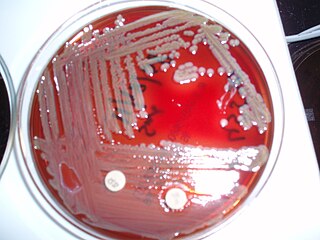
Yeasts are eukaryotic, single-celled microorganisms classified as members of the fungus kingdom. The first yeast originated hundreds of millions of years ago, and at least 1,500 species are currently recognized. They are estimated to constitute 1% of all described fungal species.

Cryptococcus is a genus of fungi in the family Cryptococcaceae that includes both yeasts and filamentous species. The filamentous, sexual forms or teleomorphs were formerly classified in the genus Filobasidiella, while Cryptococcus was reserved for the yeasts. Most yeast species formerly referred to Cryptococcus have now been placed in different genera. The name Cryptococcus comes from the Greek for "hidden sphere". Some Cryptococcus species cause a disease called cryptococcosis.

Cryptococcus neoformans is an encapsulated yeast belonging to the class Tremellomycetes and an obligate aerobe that can live in both plants and animals. Its teleomorph is a filamentous fungus, formerly referred to Filobasidiella neoformans. In its yeast state, it is often found in bird excrement. Cryptococcus neoformans can cause disease in apparently immunocompetent, as well as immunocompromised, hosts.

The class Flavobacteriia is composed of a single class of environmental bacteria. It contains the family Flavobacteriaceae, which is the largest family in the phylum Bacteroidota. This class is widely distributed in soil, fresh, and seawater habitats. The name is often spelt Flavobacteria, but was officially named Flavobacteriia in 2012.
Papiliotrema is a genus of fungi in the family Rhynchogastremaceae. Filamentous states, where known, form septate basidia with haustorial cells indicating they are parasites of other fungi. Most species are currently known only from their yeast states. More than 20 species have been referred to Papiliotrema.
Aspergillus lentulus is a species of Aspergillus fungus. It is a close relative of Aspergillus fumigatus. It has smaller conidial heads with diminutive vesicles compared to A. fumigatus, and cannot survive at 48 °C (118 °F). It also has decreased in vitro susceptibilities to multiple antifungals, including amphotericin B, itraconazole, voriconazole, and caspofungin. Aspergillus lentulus is an opportunistic human pathogen that causes invasive aspergillosis with high mortality rates. It has been isolated from clinical and environmental sources. Since it was described in 2005 as a new species, it was thought to reproduce only asexually. However, in 2013 Swilaiman et al. (2013) found that A. lentulus has a functional sexual cycle. During this cycle cleistothecia are produced that, when mature, contain heat-resistant ascospores.
Hanseniaspora guilliermondii is a species of yeast in the family Saccharomycetaceae. In its anamorph form, it is called Kloeckera apis.

Phaeotremella is a genus of fungi in the family Phaeotremellaceae. All Phaeotremella species are parasites of other fungi and produce anamorphic yeast states. Basidiocarps, when produced, are gelatinous and are colloquially classed among the "jelly fungi". Fifteen or so species of Phaeotremella are currently recognized worldwide. Tremella sanguinea, shown to be a Phaeotremella species by DNA sequencing, is cultivated in China as an ingredient in traditional Chinese medicine.
Pseudotremella is a genus of fungi in the family Bulleraceae. All Pseudotremella species are parasites of other fungi and produce anamorphic yeast states. Basidiocarps, when produced, are gelatinous and are colloquially classed among the "jelly fungi". Four species of Pseudotremella are currently recognized worldwide. Two of these species are, as yet, only known from their yeast states.
Naganishia vishniacii is an extremophile fungus originally isolated as a yeast from soil samples in the dry valleys of Antarctica. The species grows at 4 degrees Celsius and below but not at 26 degrees Celsius and above. Visually it is characterized as a cream mass in culture. It is nonfermentative and assimilates glucose, maltose, melezitose, trehalose, and xylose. Molecular research, based on cladistic analysis of DNA sequences, shows that the species does not belong in the Cryptococcaceae.
Naganishia antarctica is a yeast species that has been isolated from soil in Antarctica.
Naganishia adeliensis is a species of fungus in the family Filobasidiaceae. It is currently only known from its yeast state, isolated from decaying algae in Antarctica.
Naganishia albida is a species of fungus in the family Filobasidiaceae. It is currently only known from its yeast state. The species was originally isolated from the air in Japan, and has subsequently been isolated from dry moss in Portugal, grasshoppers in Portugal, and tubercular lungs.
Mrakia aquatica is a species of fungus in the family Mrakiaceae. It is only known from its yeast state, originally isolated from lake water in England.
Hanseniaspora clermontiae is a species of yeast in the family Saccharomycetaceae. It was first isolated from stem rot occurring in a lobelioid plant in Hawaii, and may be endemic to the Hawaiian Islands.
Hanseniaspora lachancei is a species of yeast in the family Saccharomycetaceae. It is associated with fermenting agave juice and a tequila production facility in Mexico.
Hanseniaspora meyeri is a species of yeast in the family Saccharomycetaceae. Samples of the species have been obtained worldwide from flowers, fruit flies, stem rot, and spoiled grape punch.
Hanseniaspora occidentalis is a species of yeast in the family Saccharomycetaceae. In its anamorph form, it was called Kloeckera javanica. It has been isolated in the wild from soil samples and vineyards. Samples of a variant have been isolated from orange juice and rotten oranges. It has demonstrated potential as an organism to reduce malic acid in wine production.
Hanseniaspora osmophila is a species of yeast in the family Saccharomycetaceae. It is found in soil and among the bark, leaves, and fruits of plants, as well as fermented foods and beverages made from fruit.
Hanseniaspora pseudoguilliermondii is a species of yeast in the family Saccharomycetaceae. Originally isolated from orange juice concentrate, it has been found on fruit and fruit juices in locations around the world. It has also been observed forming hybrids with Hanseniaspora opuntiae.



